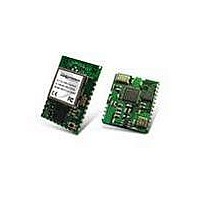RK-WI.USB-DTS-R Radiotronix, RK-WI.USB-DTS-R Datasheet - Page 11

RK-WI.USB-DTS-R
Manufacturer Part Number
RK-WI.USB-DTS-R
Description
RF Modules & Development Tools Wi.USB-DTS Dev Kit w/ Rohs Base St
Manufacturer
Radiotronix
Datasheet
1.RK-WI.USB-DTS-R.pdf
(18 pages)
Specifications of RK-WI.USB-DTS-R
Lead Free Status / RoHS Status
Lead free / RoHS Compliant
Other names
RK-WIUSB-DTS-R
WI.USB-DTS-R DATASHEET
4. Using the Evaluation Software
4.1. Setting Register Values
On both the Volatile and Non-Volatile pages, the registers are labeled by function. To set a register value, select
the value from the options available for that register and click the “Write” button. To perform a read of that
register, simply click the “Read” button. Descriptions of the register functions can be found in the Wi.232DTS-R
Users Manual.
4.2. Diagnostic Command Modes
There is a special class of commands available through the evaluation software. These controls are located on
the “Volatile Registers” page as seen below.
Figure 6: Diagnostic Command Modes
These commands place the module into special diagnostic modes that can be used to test the module’s
performance, or to activate the transmitter for RF testing purposes. It is important to note that once a module
executes a diagnostic command, it should be reset or have the power cycled to return to normal operation.
4.2.1. Transceiver Mode
This selects the modulation mode and power output of both the transmitter and receiver. The mode is not set
until “Set TX Diag” or “Set RX Diag” is pressed. If “Set RX Diag” is pressed, the power output value is
ignored.
4.2.2. Transmit Diagnostic
Transmit Diagnostic consists of four radio buttons which select the transmit channel. Low, Mid and High are
quick reference buttons which can be used to select the lowest, the middle, or the highest channel. Any
specific channel can be selected by using the controls below the “Set TX Diag” button.
10
Chapter
4
TM














